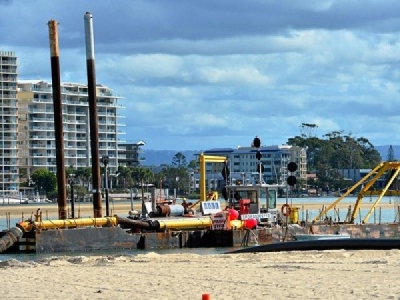
Posted on September 21, 2017
By Bill Hoffman, Sunshine CoastDaily
A $700,000 sand-dredging operation described as “robbing Peter to pay Paul” will end at the Maroochy River mouth this week.
However despite criticism the sand pumped onto Maroochydore Beach has created dangerous surf conditions, Sunshine Coast Council remains intent on continuing the exercise in two years’ time depending, according to a spokeswoman, “on monitoring results of beach profile, sand source availability and budget allocation”.
“Dredging operations are due to be completed in coming days and demobilisation of equipment from site will occur this week,” she said.
“During the program, 100,000 cubic metres was relocated from the Maroochy River mouth to the sand dunes.”
The three-month dredging operation halved the amount of sand forming Flathead Point and follows similar work in 2013 (125,000 cubic metres) and 2015 when 75,000 cubic metres was moved from the river mouth to the beach.
Last year the council shifted a further 20,000 cubic metres to ‘top up’ the beach.
The 2017 pumping operation went ahead despite there being historical levels of sand on all coast beaches and according to surfers has destroyed banks leaving just a straight dumping wave similar to the Mooloolaba shore break.
Matthew Barnes, senior coastal engineer with BMT WBM, said while the exercise provided some benefit it didn’t provide a huge storm buffer.
Commenting on the work when it started Mr Barnes said the Alexandra Headland to Maroochydore stretch of beach and the mouth of the Maroochy River formed part of the same system that had suffered a nett loss of sand over time.
“It’s robbing Peter to pay Paul,” he said at the time. “It’s sand recycling rather than nourishment. To do that you need to bring new sand in.
“To get more sand into the system it has to come from outside.”
He suggested that in the short term sand could be purchased from the Port of Brisbane and brought to the Coast by barge. Long-term there was a need for an offshore reserve potentially south and offshore from Point Cartwright.
The council has argued the sand pumping was essential to the ongoing protection of the adjacent assets that relied on the beach and dune system to act as a buffer for protection from storm erosion.
“In addition to allowing the shoreline to respond to natural erosion events, it also helps ensure our beaches are in great shape for the upcoming summer season,” the spokesperson said. ?
Source: Sunshine CoastDaily





